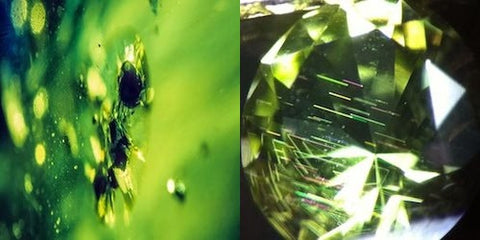Peridot Clarity
Well known as the birthstone for August, Peridot is a stunning green stone. For thousands of years, this stone has been popular. In fact, the Egyptians called peridot the stone of the sun. It's even been confused for emerald.
However, unlike emerald, it doesn't cost a lot of money. When buying Peridot there are a number of things to consider, but one of the biggest is clarity. So, what should you as a customer know about this? We'll discuss Peridot clarity in this article.
TABLE OF CONTENTS
Peridot Described
Gemologists refer to Peridot as olivine, which is an iron magnesium silicate. Because it always contains iron, Peridot only comes in green, although there's still variation in Peridot color. In particular, the finest Peridot is a slightly yellowed green known as “Peridot green.” In addition, this is a gemstone that tends to have a high clarity grade.

Lily Pads
Lily Pad inclusions in Peridot are distinctive. Specifically, these are rounded fractures that reflect light. Since the light reflection is uneven, Peridot lily pad inclusions appear to have veins going through them, making the name of these features even more descriptive. According to the GIA, lily pads is type of inclusion that's the most common in raw Peridot.

Black Specks and Needles
These inclusions are descriptively named. At their most basic, black specks are crystals that were trapped in the larger Peridot crystal during formation. Needles are very thin crystals that, like their black counterparts, got trapped. Both of these inclusions are relatively common in Peridot.

Other Inclusion Types
In addition to the above inclusion types, a Peridot stone can have other inclusions. Feathers and etch channels are, like lily pads, cracks that form within the Peridot crystal as it grows. Internal and surface graining are growth lines within the Peridot gemstone, kind of like the rings on a tree. Lastly, a cavity forms when a small air bubble gets trapped and can't get out.
Improving Clarity: Gemstone Cutting
While most of us wouldn't think of making Peridot jewelry with an uncut stone, this process is one of the ways in which we can improve clarity. Probably the biggest reason that this works is that parts of the rough Peridot that have inclusions can be cut away. So, before a Peridot crystal reaches the market, it's usually cut. There are three main methods: step cuts, brilliant cuts, and cabochons.

Step Cuts
Step cuts are faceted cutting styles. Their distinctive feature are facets that are either square or rectangular. One of the biggest reasons gem cutters select a step cut is that they showcase the color and clarity of a Peridot gemstone. You can easily look through the cut gem and see its lovely color without seeing inclusions.
The most popular step cut for Peridot jewelry is the emerald cut. Emerald cuts are fat rectangles with the parallel facets and the corners cut off. Other step cuts include baguette, which is a thinner rectangle, and Asscher. This last cut is square in shape.

Brilliant Cuts
Unlike step cuts, a brilliant cut peridot gemstone has curved lines and kite or triangular facets. Gem cutters choose a brilliant cut when they want to showcase the brilliance and fire of a gemstone, and this is one reason brilliant cuts are so popular with diamonds.
By far the most popular brilliant cut is the round brilliant. Those who are looking for a Peridot engagement ring should consider this one because it's such a classic option. Other brilliant cuts include the oval, princess (rounded square), marquise (sharp-pointed oval), pear, and heart.

Cabochons
When a peridot crystal isn't as clear, or when an artistic look is desired, the gem cutter may make a cabochon. This is basically a domed shape, usually a circle or oval. Rough peridot is shaped, then polished to a bright shine. In this case, the object is to show off a pretty color or interesting patterning as a result of inclusions.
FAQs
Does peridot have inclusions?
How to pick a good quality peridot?
What is the best type of Peridot?
What color peridot is most valuable?









